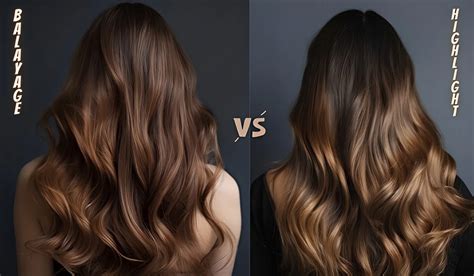Introduction
When it comes to hair coloring, balayage and highlights reign supreme as the most sought-after techniques. Both methods involve lightening hair strands for a more vibrant and dynamic look, but their techniques and results differ significantly. This comprehensive guide delves into the intricate nuances of balayage hair versus highlights, empowering you to make an informed decision that aligns with your desired aesthetic.

Balayage Hair: The Freehand Art of Hair Painting
1. Technique:
Balayage, a French term meaning “to sweep,” entails a freehand painting technique where hair sections are meticulously swept away from the root and painted with lightener. This artistic approach creates a soft, blended gradation that seamlessly transitions from darker roots to lighter tips.
2. Placement:
Balayage focuses primarily on the mid-lengths and ends of the hair, leaving the roots untouched or subtly lightened. This strategic placement mimics the natural sun-kissed effect, adding depth and dimension without stark demarcation lines.
3. Results:
Balayage hair boasts a low-maintenance allure, requiring fewer touch-ups than traditional highlights. The gradual color transition allows for a more natural, lived-in look that effortlessly complements all hair textures and face shapes.
Highlights: The Classic Coloring Technique
1. Technique:
Highlights involve isolating and selectively bleaching small strands of hair, typically using a foil or plastic cap. This precise technique creates distinct, contrasting streaks throughout the hair.
2. Placement:
Highlights can be placed in various patterns and sections, including vertical, horizontal, or diagonal lines. The choice of placement influences the overall effect, from subtle pops of color to a more dramatic, high-contrast look.
3. Results:
Highlights provide a bolder, more noticeable color change compared to balayage. They can be tailored to create striking contrasts or delicate, blended effects, depending on the desired intensity.
Balayage Hair vs Highlights: Key Differences
| Feature | Balayage Hair | Highlights |
|---|---|---|
| Technique | Freehand painting | Foil or cap |
| Placement | Mid-lengths and ends | Throughout hair |
| Result | Soft, blended transition | Distinct, contrasting streaks |
| Maintenance | Low-maintenance | Requires regular touch-ups |
| Cost | Generally more expensive | More affordable |
Which Technique Is Right for You?
The choice between balayage hair and highlights hinges on your individual preferences, hair type, and desired result.
Balayage Hair:
- Ideal for those seeking a natural, sun-kissed look with minimal maintenance
- Suitable for all hair textures and face shapes
- Creates subtle, blended transitions
Highlights:
- Preferred by those who desire bolder, more noticeable color contrast
- Can be tailored to various patterns and sections
- Requires regular touch-ups to maintain vibrancy
Statistics and Market Trends
According to a recent survey by Statista, 58% of women in the United States consider hair highlights to be their preferred hair coloring technique. However, the popularity of balayage has surged in recent years, with industry experts predicting a 20% annual growth rate in the balayage market. This surge in popularity stems from the demand for low-maintenance, natural-looking hair color.
Pain Points and Motivations
Pain Points:
- Balayage hair can be more expensive than highlights
- Both techniques require regular upkeep to prevent fading and discoloration
- Improper application can lead to damage and breakage
Motivations:
- Both balayage and highlights can enhance hair’s health and appearance
- They offer endless possibilities for customization and personalization
- Can boost confidence and self-esteem
Common Mistakes to Avoid
- Applying balayage or highlights on damaged hair
- Overprocessing the hair, leading to breakage and discoloration
- Failing to use appropriate color products and techniques
- Not maintaining the color regularly, resulting in dullness and fading
FAQs
1. How often should I get balayage hair or highlights?
The frequency of touch-ups depends on hair growth and the desired look. Balayage typically requires less frequent touch-ups due to its blended transition, while highlights may need more regular maintenance.
2. Can I color my hair myself using balayage or highlights?
While DIY kits are available, it’s highly recommended to consult a professional hairstylist for proper application and color selection. Attempting these techniques at home can lead to uneven results and hair damage.
3. What hair colors are best suited for balayage or highlights?
Balayage and highlights can be applied to all hair colors, but they are particularly effective on brown and blonde hair shades. However, copper and red hair may require special formulations to achieve the desired results.
4. How long do balayage and highlights last?
The longevity of both techniques depends on hair growth, product quality, and proper care. Balayage typically lasts longer due to its subtle transition, while highlights may require more frequent touch-ups to maintain vibrancy.
5. What are the alternative hair coloring techniques?
Aside from balayage and highlights, there are numerous other hair coloring techniques such as ombre, dip dye, and foilyage. These techniques offer distinct effects and can be tailored to individual preferences.
6. Is balayage or highlights better for fine hair?
Both balayage and highlights can be suitable for fine hair, but balayage may be more flattering as it creates the illusion of thicker, fuller hair. Highlights can also be beneficial if used sparingly to add subtle contrast and definition.
Conclusion
Balayage hair and highlights offer distinct aesthetic benefits, catering to diverse hair types and coloring preferences. While balayage provides a natural, low-maintenance look, highlights deliver bolder, more noticeable contrast. Understanding the nuances of each technique empowers you to make an informed decision that aligns with your desired hair transformation. Whether you opt for the soft, blended effect of balayage or the striking, contrasting streaks of highlights, professional application and proper care ensure stunning results that enhance your hair’s health and appearance.
